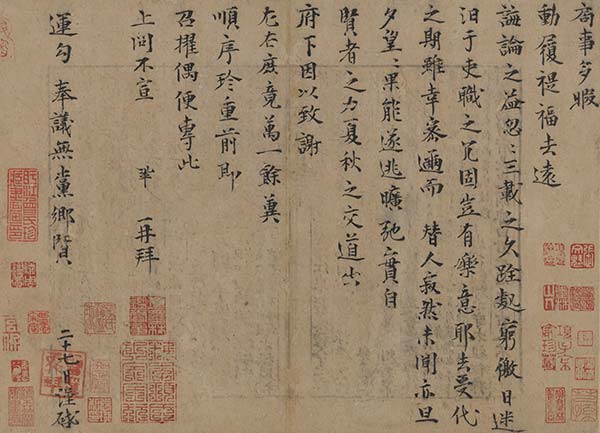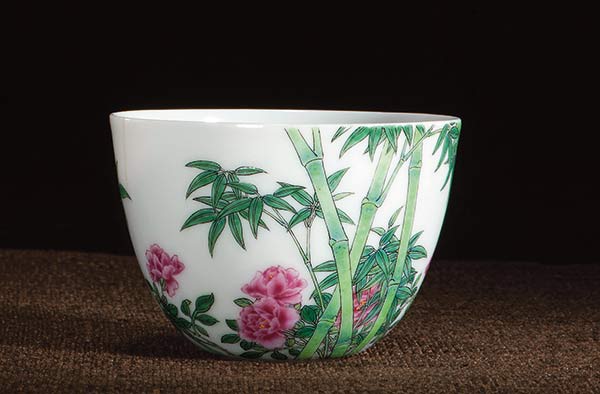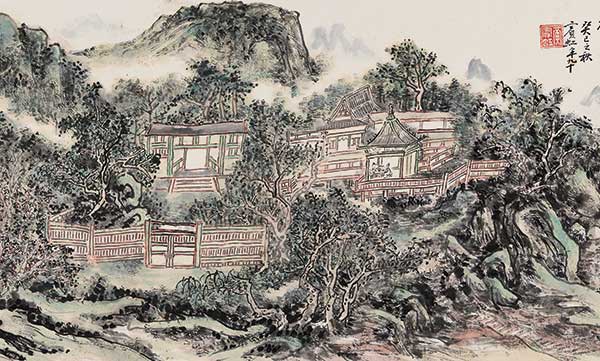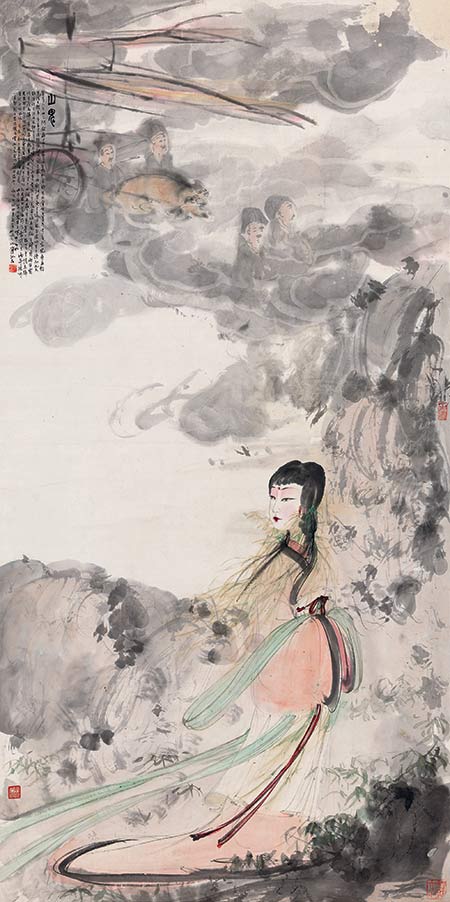
 |
|
Highlights of the upcoming auctions in Beijing include Song Dynasty (960-1279) politician Zeng Gong's Jushi Tie. [Photos provided to China Daily] |
Ancient scholar's prized letter set to attract stratospheric bids at an upcoming Beijing auction. Lin Qi reports.
A letter that a famed scholar wrote about 1,000 years ago will be auctioned in Beijing on Sunday. The letter, which has 124 characters, is expected to yield hundreds of thousands of yuan, giving it a very high value on a per-character basis.
On Sept 27, 1080, Zeng Gong wrote to a close friend whom he hadn't seen in three years.
Zeng, a Song Dynasty (960-1127) politician and literati, had been assigned to different local administrations over a 12-year period.
The letter declares the 61-year-old's gratitude for his friend's longtime support. Zeng also expresses anxiety about not being able to serve in the royal court and fully implement his ideas about governance.
Less than a month after the letter was posted, Zeng was called to the royal capital of Kaifeng, in today's Henan province, where Emperor Shenzong promoted him to an imperial post.
Zeng is regarded by later scholars as one of the "eight masters of prose of the Tang (AD 618-907) and Song dynasties", a designation that also includes his contemporaries, Ouyang Xiu and Wang Anshi.
 |
|
Highlights of the upcoming auctions in Beijing include a Qing Dynasty (1644-1911) enamel cup. [Photo provided to China Daily] |
The letter, titled Jushi Tie, which translates as "a letter on happenings", is written in kaishu, the regular calligraphic script. It will be auctioned at a China Guardian Auctions night sale.
The letter was once part of the collection of the Belgian couple Guy and Myriam Ullens, who sold it in 2009 for 108.64 million yuan ($17 million) at a Poly Auction sale in Beijing.
China Guardian hasn't revealed the current seller's identity.
Guo Tong, who heads the company's Chinese paintings and calligraphy department, says it is "an old customer", and they hope the letter will boost the sluggish Chinese paintings market.
Zeng isn't celebrated as a calligrapher.
However, he collected and studied calligraphic inscriptions on ancient bronze ware and stone tablets-it is said he had more than 500 pieces-which nourished his writing technique.
 |
|
Highlights of the upcoming auctions in Beijing include an ink painting by modern master Huang Binhong. [Photo provided to China Daily] |
Jushi Tie exemplifies Zeng's elegant and neat penmanship. The letter is sought after by collectors, since few of his writings survive.
The letter is important to understanding the official's life because it expresses deep personal feelings, says Yin Guanghua a Beijing-based painter and connoisseur of Chinese painting.
The few lines convey his disappointment with how high-ranking officials were running the country and his deep sorrow about lacking the opportunity to realize his political ideas. Indeed, Zeng's vision for reforms diverged from chancellor Wang Anshi's.
Yin says the letter also shows that, although Zeng had earned a good reputation as a local administrator, he felt a need-as a responsible statesman and intellectual-to change the country. Zeng died three years after he wrote the letter.
The letter boasts a sound provenance that is proven by the seals of several important collectors it bears. Among them there were Xiang Yuanbian, a Ming Dynasty (1368-1644) collector of books and letters; An Yizhou, a perceptive Qing Dynasty (1644-1911) connoisseur of cultural artifacts; and Zhang Congyu, a modern master of appraising Chinese paintings.
China Guardian will auction 44 other Chinese paintings and calligraphy pieces dating to the Qing Dynasty and earlier in one of its two Grand View night sales. The sales, which also see the auctioning of modern Chinese paintings, often generate high prices.
 |
|
Mountain Fairies, an ink painting by modern master Fu Baoshi, will also be auctioned. [Photo provided to China Daily] |
Another two ancient works expected to see competitive bidding include a calligraphy album in caoshu (running script) by Ming calligrapher Song Ke and an album of calligraphic Buddhist sutras, poems and paintings by Tang-era and later literati.
The ancient Chinese painting and calligraphy market posted a stable performance last year, when the modern Chinese painting bubble burst.
An imperial painting of Emperor Qianlong's favorite consort, Chunhui, by Italian court painter Giuseppe Castiglione brought in HK$137.4 million ($17.7 million) at Sotheby's auction in Hong Kong last October.
Xu Cuiyun, a researcher of the Beijing-based Art Market Monitor of Artron, says that while the volume of ancient Chinese paintings sold decreased 14 percent last year, they grossed a 10 percent increase in turnover.
Xu says that last year's grand Shi Qu Bao Ji Catalog art exhibition at the Palace Museum ignited interest in classical paintings.
But she adds that few museum-quality and authenticated works were available.

Presented by Chinadaily.com.cn Registration Number: 10023870-7
Copyright © Ministry of Culture, P.R.China. All rights reserved